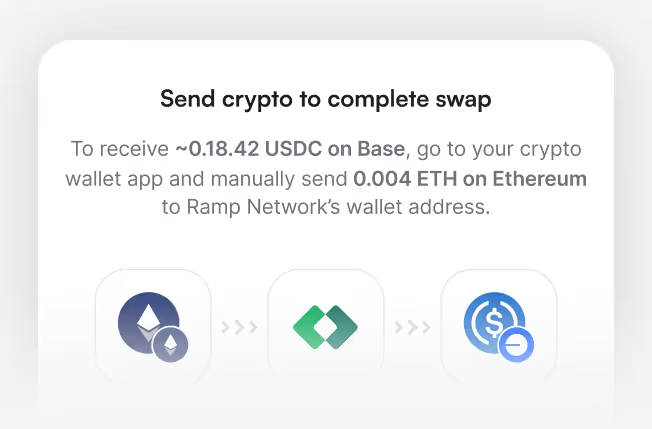


Swap BNB to ETH instantly.
Exchange Binance Coin (BNB) for Ethereum (ETH) quickly and securely with Ramp Network. A clear, step-by-step process with no bridges, no DEXs, and no hidden steps.


.svg)










Exchange Binance Coin (BNB) for Ethereum (ETH) quickly and securely with Ramp Network. A clear, step-by-step process with no bridges, no DEXs, and no hidden steps.


.svg)







Swapping Binance Coin (BNB) for Ethereum (ETH) with Ramp Network is fast, secure, and simple.

1
Choose Binance Coin (BNB) and Ethereum (ETH), enter the amount you want to swap, and check the live rate before proceeding.

2
Register using your preferred method and confirm your country of residence to continue.

3
Ramp Network supports both self-custodial wallets like MetaMask or Ledger and custodial exchange accounts. You stay in full control from start to finish.

4
Transfer BNB from your wallet. Once confirmed on the blockchain, the equivalent amount of ETH is delivered directly to your selected wallet or exchange account.

Ramp Network supports both self-custodial wallets such as MetaMask or Ledger and custodial exchange accounts. When swapping BNB for ETH, you simply connect your wallet, review the details, and confirm the trade.






The process is designed to stay intuitive and straightforward. Ramp Network removes unnecessary blockchain jargon, making BNB-to-ETH swaps accessible even for first-time users.
You remain in full control of your assets. BNB is sent directly from your wallet, and ETH is delivered to the wallet or exchange account you choose. Ramp Network never holds user funds beyond what’s required for settlement.
Ramp Network operates in key regions including the UK, EU, and US. Supported assets and networks are clearly shown during checkout.

Before you finalize your BNB-to-ETH swap, you’ll see a detailed summary of the transaction, including live rates and any applicable fees, so you always know what to expect.
*When compared to transferring via an exchange

BNB was launched in 2017 as the utility token for the Binance exchange, but it quickly grew into something much larger. Today, it fuels the entire BNB Chain ecosystem, one of the world’s most active blockchains for decentralized applications, payments, and smart contracts.
People use BNB every day to pay network fees, join token launches, access DeFi services, and transfer value globally. Over the years, the network has become faster, more efficient, and easier to build on, attracting developers from every part of the world.
BNB also has a unique deflationary model. A portion of its supply is regularly burned, reducing the total number of tokens in circulation. This approach supports long-term sustainability and rewards people who continue to hold and use BNB across the ecosystem.
Today, BNB stands as one of the largest cryptocurrencies by market capitalization. It’s no longer just a utility token but a key part of how modern blockchain infrastructure works, supporting millions of daily transactions and thousands of applications.
The chart displays an indicative, mid-market exchange rate. Effective exchange rate might be different.

Ethereum was introduced in 2015 and completely changed how people thought about blockchain technology. Unlike Bitcoin, which focused on digital payments, Ethereum made it possible to run programs directly on-chain through something called smart contracts. That idea created the foundation for DeFi, NFTs, and most of the Web3 ecosystem we know today.
ETH is the currency that powers it all. It’s used to pay for transactions, stake to secure the network, and interact with thousands of decentralized applications built on Ethereum. Developers use it as the base layer for innovation, while users rely on it to store and exchange digital value safely.
In 2022, Ethereum moved from proof-of-work to a proof-of-stake system, cutting its energy consumption by more than 99%. The network continues to evolve, becoming faster and more scalable without changing its original purpose, to provide an open, permissionless platform where anyone can build, trade, and innovate.
Bitcoin (BTC) is the world’s first cryptocurrency, launched in 2009 by the mysterious creator known as Satoshi Nakamoto. Built on blockchain technology, Bitcoin introduced a new way of transferring value online without the need for banks or intermediaries. Its decentralized nature, combined with a fixed supply of 21 million coins, makes it a unique digital asset often referred to as “digital gold.”
Today, Bitcoin is the most recognized and widely used cryptocurrency worldwide. Millions of people use it for trading, investing, and cross-border payments, while businesses across industries accept Bitcoin payments as a secure and transparent alternative to traditional money. Its popularity continues to grow, supported by increasing adoption from financial institutions, mainstream investors, and even governments exploring Bitcoin regulation.
What makes Bitcoin special is its combination of scarcity, security, and decentralization. Unlike fiat currencies that can be printed endlessly, Bitcoin’s supply is limited, creating long-term value potential. Its blockchain is maintained by thousands of nodes across the globe, ensuring transactions remain transparent and resistant to censorship. For many users, Bitcoin represents more than just an investment — it’s a revolutionary step toward financial freedom and the future of money.
The chart displays an indicative, mid-market exchange rate. Effective exchange rate might be different.
Customers like you have traded over $1 billion in crypto with Ramp Network.